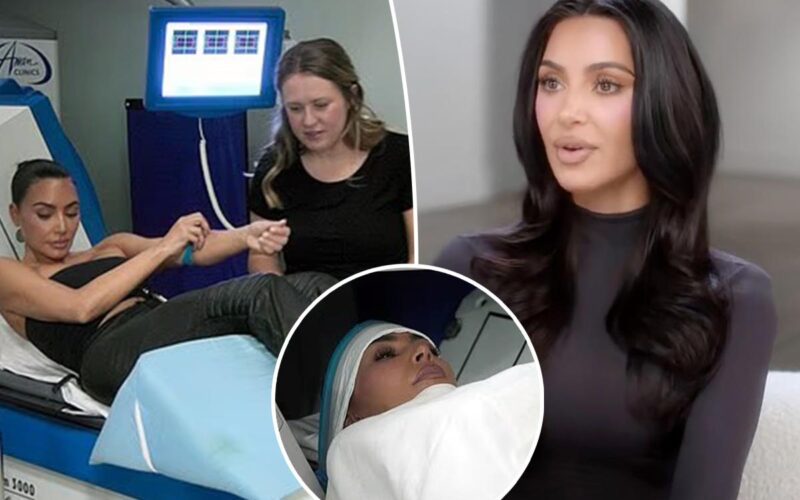Years of drama may have finally taken their toll on Kim Kardashian.
The 45-year-old reality star revealed in the Season 7 premiere of “The Kardashians” on Thursday that doctors found a “little aneurysm” in her brain during a recent MRI.
Stunned by the diagnosis, Kim asked “why the f–k” it was happening — and doctors told her “stress” could be to blame.
And Kim’s had plenty of that. The mother of four — who shares North, 12, Saint, 9, Chicago, 7, and Psalm, 6, with ex-husband Kanye West — suggested her tumultuous divorce and years of co-parenting with the “Donda” rapper may have been to blame.
“I feel more stressed probably just because I have to protect my kids,” Kim said later in the episode. “Everyone around can handle [the drama], but I want to protect my babies.”
Now fans are asking: How dangerous is the ticking time bomb inside Kim’s head? Here’s what to know about the reality star’s potentially life-threatening diagnosis.
What is a brain aneurysm?
It’s a weak spot in an artery in or around the brain that bulges and fills with blood, creating a silent threat that can burst without warning.
In the US, roughly 6.8 million Americans, or about 1 in 50 people, have a brain aneurysm. However, most have no clue until it ruptures or is spotted on a medical scan for something else.
What are the symptoms?
Most brain aneurysms are small and don’t cause any problems. But when the bulge presses on nearby structures — like nerves to the eye — people might notice warning signs, according to Johns Hopkins Medicine.
These may include pain above or behind one eye, a blown-out pupil, vision changes, numbness on one side of the face and seizures.
For most, the first sign of a brain aneurysm is when it bursts. That’s when symptoms hit hard and fast, often causing:
- The worst headache of your life — or a sudden “thunderclap” of pain
- Stiff neck
- Nausea and vomiting
- Confusion or drowsiness
- Blurry or double vision
- Sensitivity to light
- Passing out
- Trouble with balance or coordination
Are brain aneurysms deadly?
Most brain aneurysms aren’t serious. But if the bulge grows and the blood vessel wall gets too thin, it can burst, causing bleeding in the brain, otherwise known as a hemorrhagic stroke, according to the Mayo Clinic.
A ruptured aneurysm is considered a medical emergency that can quickly turn deadly. About half of all ruptured brain aneurysms are fatal, with most deaths caused by massive brain injury from the initial bleed.
Of those who survive, roughly two-thirds suffer permanent brain damage or neurological problems, according to the Brain Aneurysm Foundation.
In the US, around 30,000 people suffer a ruptured aneurysm every year — that’s one every 18 minutes.
Worldwide, brain aneurysms cause nearly 500,000 deaths annually, with half of the victims under 50.
Who’s at risk?
Brain aneurysms form when the walls of arteries in the brain become thin and weak. Some people are born with them, while others develop them over time due to various risk factors.
Inherited conditions like fibromuscular dysplasia, vascular Ehlers-Danlos syndrome and arteriovenous malformation can increase your chances. Having a parent or sibling with a history of aneurysms also raises the risk.
Lifestyle factors play a role, too. Smoking, heavy drinking, drug use, high blood pressure, and past head injuries may all boost your odds.
Overall, aneurysms are more common in women and mostly affect adults between 30 and 60.
Can stress cause brain aneurysms?
Not exactly. But chronic stress can raise your blood pressure and damage blood vessels over time — both factors that may help aneurysms form.
Emotional stress can also cause sudden spikes in blood pressure, which might trigger a rupture in an existing aneurysm.
How are brain aneurysms treated?
Not all of them need treatment.
For small aneurysms without symptoms, doctors usually recommend regular scans to keep an eye out for any chances. They’ll also urge patients to quit smoking and keep their blood pressure under control.
However, a leaking or ruptured aneurysm is considered a medical emergency that requires immediate surgery.
One common method is surgical clipping — where doctors remove a piece of the skull, then clip the blood vessel feeding the aneurysm to stop blood flow.
A less invasive option is endovascular treatment, which uses a catheter threaded through an artery to place tiny coils or stents inside the aneurysm, sealing it off and preventing rupture.








